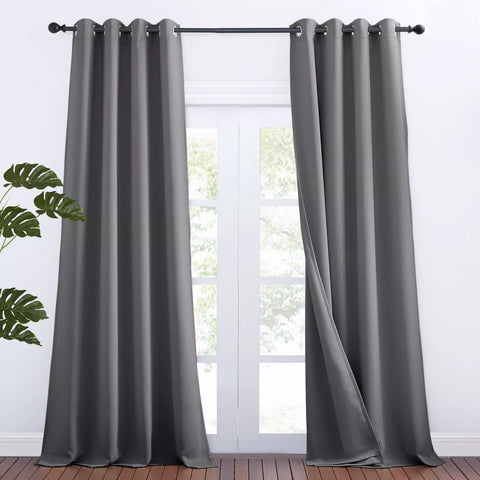Winter is a harsh season for us. Instead of venturing outside home to challenge freezing cold temperature and howling wind, most of us will choose to stay warm and cozy at home. However, cold air will inevitably infiltrate your indoor space, driving up your energy bill. Then how to keep cold air from coming through windows and doors in the winter? The solution is to winterize windows and doors to achieve window and door insulation. Following are several effective ways regarding different needs to weatherproof windows and doors for you.
Window and Door Insulation by Curtains
Changing regular curtains into thickened or thermally-lined types is another popular solution for many years to winterize windows. They are specifically designed to function for the winter season through using thicker fabric, adding extra filling or lining, etc. In the meanwhile, they still preserve the aesthetic value.
Thermal Curtains with Thick Padding
This kind of thermal insulated curtains for door/window winterizing is stuffed by soft and warming material like cotton between 2 layers of fabric. Therefore, they are thick enough to trap more heat inside and prevent the cold air from directly entering through the sides of the curtains.
Thermal Insulated Thickened Cotton Door Curtain by KGorge aims at satisfying the needs of homes located at colder areas, and it's applicable for both window and door insulation. There's a cotton-like filling between two layers of fabric, making them extra thick and full. And with 3 installation options available (self-sticky, buckle rivets and rod pocket on both sides), they're really easy to put on, too!


Thermal Curtains with Multiple Layers
Regarding winterizing windows and doors, curtains with multiple layers (usually 2-4 layers) have the edge over single-layer curtains in many aspects. And there are wider range of colors and styles for you to choose compared with thickened cotton curtain mentioned above. First of all, these curtains reduce heat pass dramatically as curtains with more layers will better limit the flow of air from the room to the window. Moreover, they could perform even better when they are floor length and hung close to the wall and window panes. In this way, the burden of your heating system will be eased and your energy bills will be lowered remarkably. Even in summer, they are able to trap cool air in as well. Therefore, these blackout thermal curtains can benefit you all year long.
Secondly, these thermal curtains are basically blackout curtains, so they can also achieve 100% blackout because layers of fabric together enhance their ability to block out sunlight and UV rays. In addition to that, multi-layered curtains are able to reduce noise, too. KGorge 3-Layer Thermal Insulated Blackout Curtain has been lab-tested to verify that it can reduce noise by 15 dB.

Weatherproof Windows and Doors from the Outside
If your house has a sunroom or sliding door, it’s more cost-efficient to use clear vinyl tarps to weather proof window and door all together from the outside in winter. They are commonly-used as patio, deck and other winter building enclosures. The clear vinyl tarps are perfect for your doors/windows in the winter if you want to enjoy outside view without being bugged by bitter winter wind leaking inside.
These tarps are much more durable than other methods due to the high-density PVC plastic they are made of. Thus, they can be used for years. And as is used outside, they are designed to be waterproof, snowpoof, UV ray resistant and cold resistant. KGorge Clear Vinyl Tarp will not crack even when the temperature reaches -22°F. It also has corded edges for extra duty strength so that the fasteners do not pop out under wind stress.

Seal Windows and Doors for Winter
There is also a more easy and temporary way to winterize windows and doors: seal windows and doors by weatherstripping and caulking. These two methods are effective in waterproofing windows and doors since they will seal the gaps between them and their frames. Therefore, if aesthetic value is not your main concern, these 2 cheap DIY hacks is a perfect fit for you.
Weatherstripping
Using weatherstripping can effectively address drafty sashes so as to weather proof windows and doors. There are many types of weatherstripping, like tension-seal, rolled-vinyl gasket, foam, etc. All of them can help you reinforce the windows and doors against the cold air. Your selection should depends on the frame type of your doors and windows.
Caulking
If your windows or doors have been used for many years, most likely the caulk around them has shrunk. This gives freezing air the chance to slip inside and drive up your heating bill. In this case, you will need to do re-caulking. That is to remove the old caulk with putty knife, use caulk gun to apply the new caulk to the gap, and finally smooth the caulk into a nice seal. This works well in addressing cracks but may cost you more time than weatherstripping.
Start with these simple and effective ways to winterize windows and doors for a warmer and cozier home. But before you apply these ways, make sure your windows and doors are in good shape without cracks.

